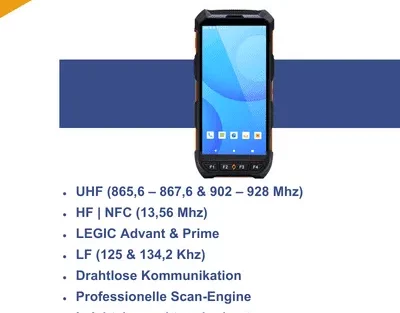Ein Einblick in das mobile Terminal C9 RED von iDTRONIC

In der sich schnell entwickelnden Landschaft der mobilen Datenerfassung und RFID-Technologie ist das mobile Terminal C9 RED von iDTRONIC ein Vorreiter in Sachen Innovation und Funktionalität. Mit seinem robusten Design, seinen vielseitigen Funktionen und seiner benutzerfreundlichen Oberfläche hat sich dieses Gerät eine Nische in Branchen wie Logistik und Fertigung, Gesundheitswesen und Einzelhandel geschaffen. In diesem Artikel befassen wir uns eingehend mit den Funktionen, Spezifikationen und Anwendungen des mobilen Terminals iDTRONIC C9 RED und zeigen auf, wie es Unternehmen hilft, ihre Abläufe zu optimieren und die Effizienz zu steigern
Allgemeine Hardware-Spezifikationen
Das iDTRONIC C9 RED zeichnet sich durch ein robustes und ergonomisches Design aus, das den harten Anforderungen in industriellen Umgebungen standhält. Seine Hardware-Spezifikationen umfassen:
- Prozessor: Das C9 RED wird von einem leistungsstarken Cortex A53 2,0 GHz Quad-Core-Prozessor angetrieben, der eine schnelle und effiziente Datenverarbeitung gewährleistet, die für Echtzeitanwendungen unerlässlich ist.
- Display: Ausgestattet mit einem lebendigen (720*1440 Auflösung) und robusten 5,5-Zoll-Gorilla-Glas-Touchscreen-Display, können Nutzer mühelos auf dem Gerät navigieren, Daten anzeigen und bequem mit Anwendungen interagieren.
- Betriebssystem: Das C9 RED läuft mit dem aktuellen Android 13 und nutzt ein vertrautes und benutzerfreundliches Betriebssystem, das eine einfache Integration von Anwendungen und Anpassungen ermöglicht.
- Drahtlose Konnektivität: Mit integriertem Wi-Fi, Bluetooth, GPS und 4G LTE gewährleistet das Gerät eine nahtlose Kommunikation, sowohl innerhalb des Unternehmens als auch mit entfernten Servern oder Cloud-Plattformen.
- Kameras: Ausgestattet mit einer 13-Megapixel-Rückkamera mit Autofokus-Objektiv und LED-Blitz sowie einer 5-Megapixel-Frontkamera war es noch
- nie so einfach, Schäden im Wartungsbereich zu melden.
- Barcode-Scanner: Die eingebauten Barcode-Scanner lesen sowohl 2D-QR-Codes als auch 1D-Barcodes auf Produktverpackungen.
- Akkulaufzeit: Die verlängerte Akkulaufzeit des C9 RED (5.200 mAh) sorgt für einen unterbrechungsfreien Betrieb während des gesamten Arbeitstages, wodurch Ausfallzeiten reduziert und die Produktivität gesteigert werden.
RFID-Fähigkeiten
Das herausragende Merkmal des iDTRONIC C9 RED sind seine RFID-Fähigkeiten. Er ist mit integrierten RFID-Lesemodulen ausgestattet, die verschiedene Frequenzen unterstützen, darunter LF (Low Frequency), HF (High Frequency inkl. NFC und LEGIC) und UHF (Ultra High Frequency). Dank dieser Vielseitigkeit und der hohen Lesereichweite eignet sich das Gerät für eine Vielzahl von Anwendungen, wie z. B.:
- Asset Tracking: Der C9 RED vereinfacht die Verwaltung von Vermögenswerten, indem er es den Benutzern ermöglicht, RFID-Etiketten an Geräten, Inventar oder Vermögenswerten schnell zu scannen und Echtzeit-Updates über deren Standort und Status zu liefern.
- Inventarverwaltung: Unternehmen können mit dem Gerät RFID-basierte Bestandszählungen und -aktualisierungen durchführen und so eine höhere Genauigkeit und Effizienz bei der Bestandsverwaltung erzielen.
- Zugangskontrolle: Das Gerät kann für sichere Zugangskontrollsysteme eingesetzt werden, die eine Authentifizierung über RFID-fähige Karten oder Ausweise ermöglichen.
- Einzelhandel: Im Einzelhandel kann der C9 RED zur Bestandsverfolgung, zur Reduzierung von Fehlbeständen und zur Verbesserung des Einkaufserlebnisses durch schnelle und genaue Preisprüfungen eingesetzt werden.
Software und kundenspezifische Anpassung
iDTRONIC hat erkannt, dass es keine Einheitsgröße für alle gibt, und daher ist das C9 RED in hohem Maße anpassbar. Das Gerät wird mit dem Software Development Kit (SDK) von iDTRONIC geliefert (inkl. Konfigurationstool für Android Studio- und Eclipse-Systeme), dass die Programmiersprache Javascript unterstützt. Die Verwendung des SDK vereinfacht und erleichtert die Anbindung an bestehende Systeme und Netzwerke.
Anwendungen in verschiedenen Branchen
Das mobile Terminal iDTRONIC C9 RED findet dank des integrierten IP65-Standards branchenübergreifend Anwendung und ist optimal gegen Umwelteinflüsse wie Staub, Wasser, Schmutz und Umgebungsbedingungen geschützt:
- Logistik und Lieferkette: In der Logistik rationalisiert es die Abläufe mit präziser Verfolgung und reduziert Fehler bei Versand und Empfang.
- Fertigung: Hersteller profitieren von einer verbesserten Qualitätskontrolle und Bestandsverwaltung.
- Gesundheitswesen: Krankenhäuser nutzen das Gerät zur Patientenverfolgung, Medikamentenverwaltung und Anlagenverwaltung.
- Einzelhandel: Einzelhändler setzen den C9 RED für die Bestandskontrolle und die genaue Preisgestaltung ein.
Das mobile Terminal iDTRONIC C9 RED verkörpert die Verbindung von Spitzentechnologie, Langlebigkeit und Vielseitigkeit. Seine RFID-Fähigkeiten in Kombination mit seiner robusten Hardware und anpassungsfähigen Software machen es zu einem unverzichtbaren Werkzeug für Unternehmen, die ihre Abläufe optimieren und ihre Produktivität steigern wollen. Der C9 RED ist bereit, Unternehmen mit der Mobilität und Effizienz auszustatten, die sie brauchen, um in der modernen Welt erfolgreich zu sein.
Mehr Informationen zu iDTRONICs mobilem Terminal C9 RED
Produkt Link: Mobile Terminal C9 RED
Produktanfragen
Herr Andreas Jäger
Tel.: +49 621 6690094-6
E-Mail: andreas.jaeger@idtronic.de

